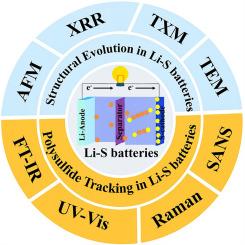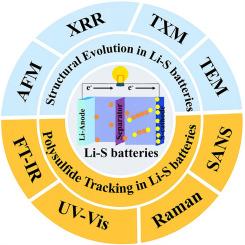Inside lithium–sulfur batteries: Real-time multimodal insights into structure and polysulfide dynamics
IF 20.2
1区 材料科学
Q1 CHEMISTRY, PHYSICAL
引用次数: 0
Abstract
Lithium–sulfur (Li–S) batteries are increasingly designated as a viable choice for future energy storage systems, owing to their substantial theoretical energy density, economic viability, and the abundant availability of sulfur. However, despite their significant potential, widespread commercialization has been limited by major obstacles, encompassing the polysulfide shuttle effect, slow sulfur redox reaction dynamics, and substantial structural degradation during cycling. To overcome these limitations and fully realize the optimal strength of Li–S batteries, a comprehensive comprehension of the fundamental electrochemical processes and real-time morphological changes during operation is crucial. This study offers a wide-ranging evaluation of recent progress in in situ and operando methods that enable direct observations of the dynamic behavior of Li–S systems under real-world conditions. Techniques including neutron scattering, X-ray tomography, X-ray reflectometry (XRR), Raman spectroscopy, small-angle neutron scattering (SANS), transmission electron microscopy (TEM), and atomic force microscopy (AFM) are examined in detail for their ability to monitor key processes like polysulfide dissolution, phase transitions, and electrochemical reactions. This review emphasizes a comparative and integrative perspective, highlighting how different diagnostic techniques collectively address critical challenges such as polysulfide migration, sluggish Li2S conversion, and electrode degradation. Furthermore, the review highlights future research avenues aimed at enhancing these experimental techniques and integrating computational models to deepen our understanding of battery degradation mechanisms. The role of machine learning in predicting battery behavior and optimizing performance is also discussed as a key area for future exploration. This review emphasizes the transformative potential of real-time monitoring in overcoming the challenges encountered by Li–S batteries, accelerating their development toward widespread adoption and large-scale application.


锂硫电池内部:实时多模态洞察结构和多硫化物动力学
锂硫电池(li -硫电池)由于其理论能量密度高、经济可行性强、硫储量丰富,越来越被认为是未来储能系统的可行选择。然而,尽管它们具有巨大的潜力,但广泛的商业化受到主要障碍的限制,包括多硫化物穿梭效应、硫氧化还原反应动力学缓慢以及循环过程中大量的结构降解。为了克服这些限制,充分实现锂- s电池的最佳强度,全面了解电池运行过程中的基本电化学过程和实时形态变化至关重要。本研究对原位和操作方法的最新进展进行了广泛的评估,这些方法可以直接观察Li-S系统在实际条件下的动态行为。包括中子散射、x射线断层扫描、x射线反射(XRR)、拉曼光谱、小角中子散射(SANS)、透射电子显微镜(TEM)和原子力显微镜(AFM)在内的技术,详细检查了它们监测多硫化物溶解、相变和电化学反应等关键过程的能力。这篇综述强调了比较和综合的观点,强调了不同的诊断技术如何共同解决多硫化物迁移、Li2S转化缓慢和电极降解等关键挑战。此外,该综述强调了未来的研究途径,旨在加强这些实验技术和集成计算模型,以加深我们对电池退化机制的理解。机器学习在预测电池行为和优化性能方面的作用也被讨论为未来探索的关键领域。这篇综述强调了实时监测在克服Li-S电池所面临的挑战、加速其向广泛采用和大规模应用方向发展方面的变革潜力。
本文章由计算机程序翻译,如有差异,请以英文原文为准。
求助全文
约1分钟内获得全文
求助全文
来源期刊

Energy Storage Materials
Materials Science-General Materials Science
CiteScore
33.00
自引率
5.90%
发文量
652
审稿时长
27 days
期刊介绍:
Energy Storage Materials is a global interdisciplinary journal dedicated to sharing scientific and technological advancements in materials and devices for advanced energy storage and related energy conversion, such as in metal-O2 batteries. The journal features comprehensive research articles, including full papers and short communications, as well as authoritative feature articles and reviews by leading experts in the field.
Energy Storage Materials covers a wide range of topics, including the synthesis, fabrication, structure, properties, performance, and technological applications of energy storage materials. Additionally, the journal explores strategies, policies, and developments in the field of energy storage materials and devices for sustainable energy.
Published papers are selected based on their scientific and technological significance, their ability to provide valuable new knowledge, and their relevance to the international research community.
 求助内容:
求助内容: 应助结果提醒方式:
应助结果提醒方式:


